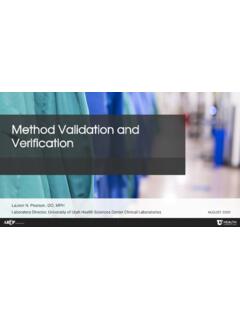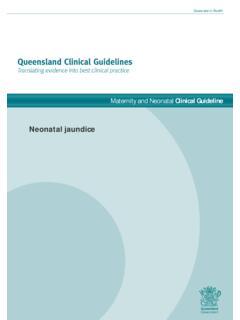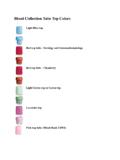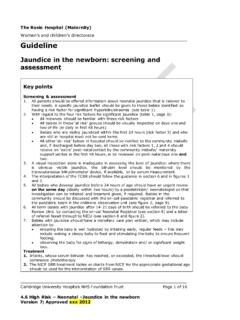Transcription of Resolution of ABO Discrepancies - University of Utah
1 Justin R. Rhees, , MLS(ASCP)CM, SBBCMR esolution of ABO the results of ABO typing, correctly identify if a discrepancy exists and if the source is most likely in the forward or reverse in detail several causes of ABO Discrepancies due to the following:a)Weak or missing reactivity in the reverse )Unexpected reactivity in the reverse )Weak or missing reactivity in the forward )Unexpected reactivity in the forward appropriate follow-up testing that is necessary in the Resolution of ABO A very important part of pretransfusion testing involves detection, recognition, and Resolution of ABO Discrepancies .
2 Discrepant results must be identified and the underlying causes Discrepancies Step 1: Repeat the test. Technical errors Specimen mix-up Forgot to wash cells Incorrect cell suspension Failure to add reagents or sample Missed hemolysis reaction (read as negative) Didn t follow procedure Incorrect centrifugation Incorrect interpretation Step 2: Request a new Steps Read the Forward Type first. Note: the Forward Type reactions may not be correct Look at the strongest reactions. The strong vs. weak reactions can provide important clues. Any time you encounter a discrepancy of any kind: 1.
3 Repeat the test to rule out technical errors. 2.) If the results are the same, record the result as: Discrepant. Only type O, Rh-compatible blood should be issued until the investigation is completed. 3). ALL Discrepancies must be investigated and resolved before the correct ABO type can be Steps Discrepancies in the reverse type are commonly encountered, and are generally due to weakly reacting or missing Type Discrepancies (Weak or Missing)Anti-AAnti-BA1 CellsB CellsPatient Result03+00 Forward TypeReverse TypeWeak or missing reactivity in reverse type Age related (<4-6 months old, elderly) Hypogammaglobulinemia Transplantation (Immunosuppressed)Investigation: Room Temperature (RT) incubation and centrifuge again.
4 This may allow the antibodies enough time to sensitize and form a lattice. (Note: reverse type testing of of neonates is unnecessary) Record on the laboratory workup that you have done this. Remember: if it wasn t documented, it wasn t done!Reverse Type Discrepancies (Extra) A2phenotype with Anti-A1 Cold-reactive alloantibody (anti-M, anti-P1, etc.) Cold-reactive autoantibody Pseudoagglutinationdue to rouleaux effect (hyperproteinemia) Transfusion of incompatible plasma components (mismatched platelets, etc.) Recent infusion of IVIG Serum antibody to reagent constituentResolution of A2with anti-A1 Anti-AAnti-B4+0A1 CellB Cell1+4+LectinPatient s CellsD.
5 Biflorus0 Antibody (RT)AHGC heck CellsScreening Cell 100 Screening Cell 200 Screening Cell 300 Auto Control00 Forward TypeReverse TypeMost Anti-A reagents react strongly with A2 CellsUnexpected Reactivity with A1 CellsNo unexpected antibodies detectedAnti-A1 lectin reacts with A1 cells only;Is non-reactive with all other A subgroupsMost standard protocols require multiple reactive A1 cells and non reactive A2 cells to prove the presence of anti-A1 Cold-reactive alloantibodyAnti-AAnti-B4+0A1 CellB Cell1+4+LectinPatient s CellsD. biflorus4+Antibody (RT)AHGC heck CellsScreening Cell 100 Screening Cell 21+0 Screening Cell 300 Auto Control00 Forward TypeReverse TypeUnexpected Reactivity with A1 CellsUnexpected cold-reactive antibody detected;Perform antibody identification panelAnti-A1 lectin reacts with A1 cells only;Is non-reactive with all other A subgroupsThis pattern is an example of A1with unexpected, cold-reactive alloantibodyCold-reactive autoantibodyAnti-AAnti-B4+0A1 CellB Cell1+4+LectinPatient s CellsD.
6 Biflorus4+Antibody (RT)AHGC heck CellsScreening Cell 11+0 Screening Cell 21+0 Screening Cell 31+0 Auto Control1+0 Forward TypeReverse TypeUnexpected Reactivity with A1 CellsPan-reactivity at room temperatureAnti-A1 lectin reacts with A1 cells only;Is non-reactive with all other A subgroupsThis pattern is an example of A1with cold-reactive autoantibodyPseudoagglutinationdue to rouleaux effectAnti-AAnti-B4+0A1 CellB Cell1+4+LectinPatient s CellsD. biflorus4+Antibody (RT)AHGC heck CellsScreening Cell 11+0 Screening Cell 21+0 Screening Cell 31+0 Auto Control1+0 Forward TypeReverse TypeUnexpected Reactivity with A1 CellsAnti-A1 lectin reacts with A1 cells only;Is non-reactive with all other A subgroupsReactions appear stringy; rouleaux effect can be seen under microscopic evaluationRouleaux usually disappears after wash stepsSaline Replacement Set up reverse type testing as you usually would.
7 Perform immediate spin ( ) centrifugation Before shaking the tubes, carefully remove all the plasma/serum with transfer pipette. Replace plasma with 2 drops of normal saline. Read reactions as you usually would. Principle of the test: if antibody-antigen lattice formation has occurred during the phase, it will remain undisturbed when you remove the plasma/serum. This should only remove interfering proteins that cause a false positive sample after saline replacementAnti-AAnti-B4+0A1 CellB Cell04+Antibody (RT)AHGC heck CellsScreening Cell 100 Screening Cell 200 Screening Cell 300 Auto Control00 Forward TypeReverse TypePseudoagglutinationdisappears after saline replacementReverse Type Discrepancies A2phenotype with Anti-A1 Cold-reactive alloantibody (anti-M, anti-P1, etc.)
8 Cold-reactive autoantibody Pseudoagglutinationdue to rouleaux effect (hyperproteinemia) Transfusion of incompatible plasma components (mismatched platelets, etc.) Recent infusion of IVIG Serum antibody to reagent constituentCase 1 Anti-AAnti-B03+A1 CellB Cell3+1+Forward TypeReverse TypeWhat is the person s most likely type?Which reaction(s) is/are suspect?What further test(s) should be performed?Case 1 Anti-AAnti-B03+A1 CellB Cell3+1+Antibody (RT)AHGC heck CellsScreening Cell 11+0 Screening Cell 21+0 Screening Cell 31+0 Auto Control1+0 Forward TypeReverse Type No rouleaux observed under microscopic investigation Results are most consistent with cold-reactive autoantibody Perform cold panel to identify specificity Possible cold autoadsorption Pre-warmed technique?
9 Case 2 Anti-AAnti-B4+3+A1 CellB Cell1+1+Forward TypeReverse TypeWhat is the person s most likely type?Which reaction(s) is/are suspect?What further test(s) should be performed?Case 2 Anti-AAnti-B4+3+A1 CellB Cell1+1+Antibody (RT)AHGC heck CellsScreening Cell 100 Screening Cell 21+0 Screening Cell 31+0 Auto Control00 Forward TypeReverse Type No rouleaux observed under microscopic investigation Results are most consistent with cold-reactive alloantibody Perform antibody identification (include immediate spin ( ) room temperature (RT) phase to identify specificity) Antigen type reagent A1 and B cellsCase 3 Anti-AAnti-B3+3+A1 CellB Cell1+0 Forward TypeReverse TypeWhat is the person s most likely type?
10 Which reaction(s) is/are suspect?What further test(s) should be performed?Case 3 Anti-AAnti-B3+3+A1 CellB Cell1+0 Antibody (RT)AHGC heck CellsScreening Cell 100 Screening Cell 200 Screening Cell 300 Auto Control00 Forward TypeReverse TypeCase 3 Anti-AAnti-B3+3+A1 CellB Cell1+0 LectinPatient s CellsD. biflorus0 Antibody (RT)AHGC heck CellsScreening Cell 100 Screening Cell 200 Screening Cell 300 Auto Control00 Forward TypeReverse TypeMost likely: A2B with anti-A1 Case 4 Anti-AAnti-B3+0A1 CellB Cell1+3+Antibody (RT)AHGC heck CellsScreening Cell 100 Screening Cell 200 Screening Cell 300 Auto Control00 Forward TypeReverse TypeWhat is the person s most likely type?













